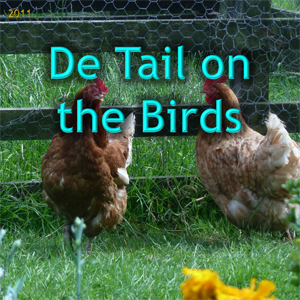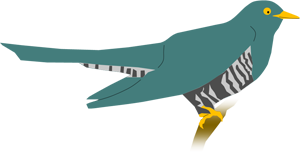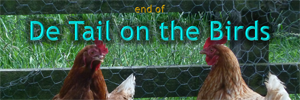“De Tail on the Birds” series of
 articles
articles
2011
Appendix

This was a monthly series of articles each focussing on a particular avian species I find interesting, though “Caledonia Gulls” features several species and is in poem form.
Feb 28 Mon “Red all about it”
I saw my first red kite on New Year’s Day 2011. It was on the Black Isle, one of the few areas of Britain where red kites are found. (The Black Isle is actually a multicoloured peninsula north of Inverness in Scotland.) The bird swooped down and landed on a fence-post on a field, then flew off again a few seconds later.
The first part of the bird’s English name derives from the colour of the bird, which is red. The “kite” bit can refer to a flying toy, like a red kite on a string, or a dishonest person. (A bit unfair on the birds!) The Milvus in the scientific name is Latin for “kite” (the bird).
Red kites were once common across Britain (Shakespeare mentioned kites at least fifteen times), and were liked during the Middle Ages for eating the bits of unpleasant meat that littered the streets. It was illegal to kill a kite, and kite-killers received capital punishment. But during the sixteenth century, kites began to be seen as vermin, it became legal to kill a kite, and kite-killers were even rewarded. Game-keepers accused the birds of taking grouse and pheasants; the increasing rarity of the birds made them more valuable to egg-collectors and suchlike. In 1871 the red kite was extinct in England; by 1879 the red kite was extinct in Scotland, and only a few survived in Wales.
Fortunately, the numbers of red kites in Wales began to increase in the late 20th century, though slowly; there were twenty pairs in 1960 (all derived from a single female). Due in part to efforts from the RSPB and Scottish Natural Heritage, the red kite species has been reintroduced to the Black Isle (where I saw two kites) and five other places in Britain.
Mar 31 Thu “Owly by the night”
Tawny owls, Stryx aluco, are birds which I’ve no photos of because I’ve never seen one. I have often heard them calling during the night (they’re nocturnal). Tawny owls are sometimes known as “screech owls” because they make the “toowit tuwoo” sounds associated with owls; I write “they” and “them” (plural) because they often duet, the female owl screeching the “toowit” and the male answering with the “tuwoooo”.
Both genders look similar: pigeon-sized (38cm long, though females are bigger than males), brown, with a broad head and a wide ring of dark feathers around each eye. Their favourite home is in deciduous forest, and they never usually venture beyond their territories. They eat small animals such as rodents, sparrows, frogs, insects, and worms.
Almost twenty thousand pairs breed in Britain; tawny owls are common across Europe, except northern Scandinavia, most of Russia, Ireland, and several islands (not surprising given their preference for deciduous forests).
Apr 30 Sat “The cuckoo clocked”
The bird I’ll clock in this essay is the cuckoo, Cuculus canorus, which I’ve no photos of because I’ve never seen one. I have however sometimes heard male cuckoos calling from deep inside forests. Indeed, cuckoos are called “cuckoos” after their distinctive and famous call, which I think sounds more like “fl-whuh-hoo”.
The cuckoo’s call has also inspired its scientific name Cuculus canorus. Cuculus is the Latin word for “cuckoo” (don’t confuse it with “cumulus”, which means “heap” in Latin and is a type of cloud in English). And canorus is Latin for “melodious”, from cano “I make music”.
I chose to write about the cuckoo in April 2011 because April is a common time for cuckoos to start arriving in Britain (they’re seasonal migrants) and start calling.
Then, while researching for this article, I discovered some interesting Celtic folklore relating to cuckoos. Cuckoos used to be known as “gowks” in Britain, pronounced like “gowns”, but with a “k” sound rather than a “n”. In Scotland, a traditional custom was to celebrate Gowk’s Day on the 13th day of April (this month), which involved playing pranks on children, like modern April (this month) Fool’s Day. (The word “gowk” also meant “fool”.) Around Gowk’s Day, cuckoos were supposed to start arriving, landing on various special “Gowk’s Stones” in Scotland and Ireland.
“Gowks” were also believed to be able to cause death, bad storms, and Spring. (There are often storms in Spring.) Gowks could also predict the dates of weddings (is that why Prince William and Kate Middleton are getting married this month?).
In 1066, the French term coucou - the conquering Normans were, of course, French - became popular in Britain, later displacing “gowk” in most areas and evolving into the modern term “cuckoo”. The bird’s association with fools was retained though, surviving in the modern usage of “cuckoo” as an adjective to mean “insane”, and in the word “cloudcuckooland” which means the place where insane people live. Apparently the word “gowk” is sometimes used in Scotland and Northern England.
Anyway, back to biology. Both genders usually look similar: dove-sized (33cm long) with a slender body and long tail rectangular tail which is splayed during courtship; cuckoos are sometimes mistaken for falcons such as peregrines. A cuckoo is grey with a hint of brown, except for its underside, which is white and striped with thin grey wobbly lines, like a sparrowhawk. The eyes and beak are yellow.
The cuckoo, as well as being well-known for its call and Spring arrival, are famous (or infamous) for not bothering to build its own nest, instead laying its egg in another bird’s nest, for the other bird to look after. The nests and young of dunnocks, reed warblers, and meadow pipits are usually hijacked in this way. After hatching, the cuckoo chick pushes the chicks that aren’t cuckoos out of the nest, being the size of three adult reed warblers so needing/wanting all the food that the deceived adult bird brings. Cuckoo chicks are able to mimic the cries of dunnock/warbler/pipit chicks very well, so the adult bird probably never realises that that fat grey ball of hungry chick is not its offspring.
The first surviving written account of the cuckoo’s egg-laying habits was by the Greek philosopher Aristotle. Over two millenia later, in 1788, Edward Jenner earned the honourable title of “Fellow of the Royal Society” for his observations of cuckoo behaviour; afterwards, he successfully vaccinated people against deadly smallpox: he’s still famous today. Not as famous as those German automated time-pieces, though.

May 31 Thu “Myna, not minor”
In April 2011 I was fortunate enough to have a holiday in Sri Lanka, where I added more than two dozen species to my life list (or IBIS, index of birds I’ve sensed, as I prefer to call it). Therefore it makes sense for me to write in detail about one of those Sri Lankan birds. So here are some data about common mynas, Acridotheres tristis.
Common mynas nest in holes in trees or buildings, so have adapted well to urbanisation and suburbanisation. They use a variety of materials to build their nests, ranging from twigs and roots to tissue-paper and abandoned snake-skin. Mynas don’t, of course, hurt the snakes, but they have been witnessed to aggressively remove live chicks from nests that woodpeckers or parakeets (etc.) have made, and take over the empty nests. Such tactics have helped (if that’s the right word) the common myna to invade South Asia (including Sri Lanka), and South-East mainland Asia, and coastal Eastern Australia, and Duncan’s Childhood Blog, and...
Therefore the International Union for the Conservation of Nature has, alongside the European starling and the red-vented bulbul, declared the common myna to be one of the world’s 100 worst invasive species. The following passage is from the IUCN’s website:
“The common myna (Acridotheres tristis), also called the Indian myna, ... lives in close association with humans. It competes with small mammals and bird for nesting hollows and on some islands, such as Hawaii and Fiji, it preys on other birds’ eggs and chicks. It presents a threat to indigenous biota [the wildlife of a region], particularly parrots and other birdlife, in Australia and elsewhere.”
Common mynas are related to those invasive European starlings, and are in several other ways similar. They’re quite small, between a sparrow and a pigeon in size. Common mynas are mostly darkly coloured except for the feet, beak, and eyes (yellow), and their belly (beigey-grey), and the ends of their tails (white). Like the starling, common mynas are common, hence the first part of their name.
Speaking of names, why’s a “myna” called a myna? It comes from the Hindi name for the bird, which I’ll transliterate as maina. “Myna” in English is sometimes also spelt “mynah” and “mina”, pronounced the same (like “miner” or “minor”).
And what does the scientific name translate as? Acridotheres derives from the Greek for “hunter of locusts” - mynas are omnivorous, with a particular fondness for the grass-hoppers - and tristis is Latin for “gloomy”, probably a reference to the drab dark-grey feathers that resemble attire worn while mourning. Avian ways are definitely different to human ways, because common mynas don’t seem to have much to mourn about, and indeed don’t seem to be mourning: they’re very chirpy and chatty and friendly, like European starlings.


Jun 30 Thu “Chick lit.”
Domestic chickens (Gallus gallus domesticus) are domesticated versions of red Jungle-Fowl (Gallus gallus). The colours of red jungle-fowl are more vivid than those of DCs. DCs and RJFs are some of the few birds that have a comb and two wattles, which are used for attracting mates (like a peacock’s tail). The comb is the red thing on the top of the head that looks a bit like a hair-comb. The wattles are under the chin and also red.
The longest lifespan recorded of a DC is thirty years. However most female DCs in commercial farms aren’t best at laying eggs if they’re older than about-eighteen-months-old, so they tend to be killed. Female DCs (hens) start laying eggs at about six-months-old.
DCs can’t fly well.
DCs have twenty-four taste-buds. Humans have nine thousand.
The heart-rate of a male DC is about 286 beats per minute, and for a female DC it’s 312.
“Snow chicken” is an informal name for the ptarmigan, a grouse that lives on snowy mountains.
The photos below show female DCs, hens. Male DCs are called cockerels, cocks, chanticleers, or roosters. The word “chanticleer” is rarely used today; it comes from the French for “clear song” and is the name of a character is one of “The Canterbury Tales”.


Jul 31 Sun “Chatterers and chatters”
Magpies are black and white, fly... unless they’ve had their wings clipped or are busy finding practical uses for mirrors. Magpies - corvids, just like crows, ravens, jays - are extremely intelligent, hence their apparent ability to recognise their reflection.
Magpies, Pica pica, are very common: in Europe are more than seven million magpies. Large population sizes, distinctive plumage, bold behaviour, and a distinctively long tail (half of entire length) have helped magpies to get into common folk-lore. Numerous superstitions concerning magpies exist in Western, Christian nations. The magpie is associated with the Devil, perhaps because the mixture of black, white, blue, and many different colours too is seen as impure. (However, there is a story that the magpie is black and white because its parents are a raven - black - and a dove - white. I’m not sure how well that fits with traditional ideas of doves being pure.) Also the boldness and curiosity of the magpie can be interpreted as arrogance.
Apparently two birds visited Jesus when he was being crucified. The magpie - adorned in splendid colours and fancy feathers - mocked Jesus; the robin meekly approached Him and sorrowfully removed His thorns, letting His blood dye its breast. Jesus blessed the robin, and cursed the magpie. So robins appear on Christmas cards, millennia later. And magpies still get their nests blown down in storms. I wrote that because in January 2007 a tree containing a magpie nest came down in my garden.
Some people are superstitious about magpies. Some such superstitions are suggested in the famous rhyme:
“One for sorrow; two for joy;
three for a girl; four for a boy;
five for silver; six for gold;
seven for a secret never to be told.”
Seven of course is the number of days in a week (thanks in part to the creation story in “Genesis”), and the number of animals of each species on board Noah’s Ark. Check the scripture if you don’t believe me. Seven is therefore a holy number, and, as magpies are “unholy”, seven magpies are never to be told (or seen).
(There is also a rhyme which goes “Clean birds in sevens, unclean in twos, the dove in the heavens is the one I choose”.)
However, in the Far East, traditional views of magpies are some-what different. In China, magpies are seen to bring happiness; their song predicting prosperity and love. In Mongolia, magpies are clever birds which control the weather. That is quite right!
Other references in culture to magpies include, in alphabetical order:
- the Magpie Brewery - makes beer in Nottinghamshire.
- Magpie Comms - a design and marketing agency.
- Magpie Cross-word Magazine - makers of puzzles.
They say that “Making A Good Puzzle Isn’t Easy”.
I reply: “My! Acronyms Generate Particularly Intense Envy!”. - the Magpies - nickname for the football team Newcastle United; their kit is black and white.
- MoneyMagpie.com - a price-comparison website.
- MusicMagpie.co.uk - a service that buys second- or third-hand CDs and computer-games.
- Magpie Recycling Ltd - a waste-disposal company in Brighton.
- Magpie Studio - a company that designs leaflets, I think.
- Magpie - a children’s television programme similar to Blue Peter, aired on ITV in the 1960s and 1970s.
As in MusicMagpie.com and Magpie Recycling Ltd, magpies are associated with taking things away. Allegedly they (the birds) steal shiny objects. As well as sparkling diamond rings, in the nest are things that magpies are proud of and sing of. The eggs are speckled, and when they hatch, what appears is such a fine brood, that one stops being broody.
To finish this article, I wish to make one thing clear. Magpies do not have a significant effect on the thrush population. (That’s “thrush” meaning the birds, not the fungal infection candidiasis.) And years ago I wrote a song about magpies, which you can read on my Poetry page. No, you can’t.
Aug 31 Wed “Caledonia gulls”
The song below (written in cloudy Caledonia) is based on “California Girls” by the Beach Boys. You can hear the Beach Boys song here, courtesy of user JanelleandSean at YouTube.
Well common gulls are cool, although they’re really rarely found;
and black-headed gulls
are so sociable
they’re always fun to have around.

The greater black-backed gulls are giants, big and beautiful,
and a kittiwake
would be pretty great
if I could see that type of gull.
I’m glad they all could be Caledonia...
I’m glad they all could be Caledonia...
I’m glad they all could be Caledonia gulls.
But herring gulls are cheeky, having lost their fear of us.
They swerve and swoop and attack
for a coveted snack
if you’re nearby and not cautious.
Some gulls can drink sea-water because they can remove the salt;
in brine the salt flows
from the sea-birds’ nose.
When gulls dribble it’s not their fault.
I’m glad they all could be Caledonia...
I’m glad they all could be Caledonia...
I’m glad they all could be Caledonia gulls.



